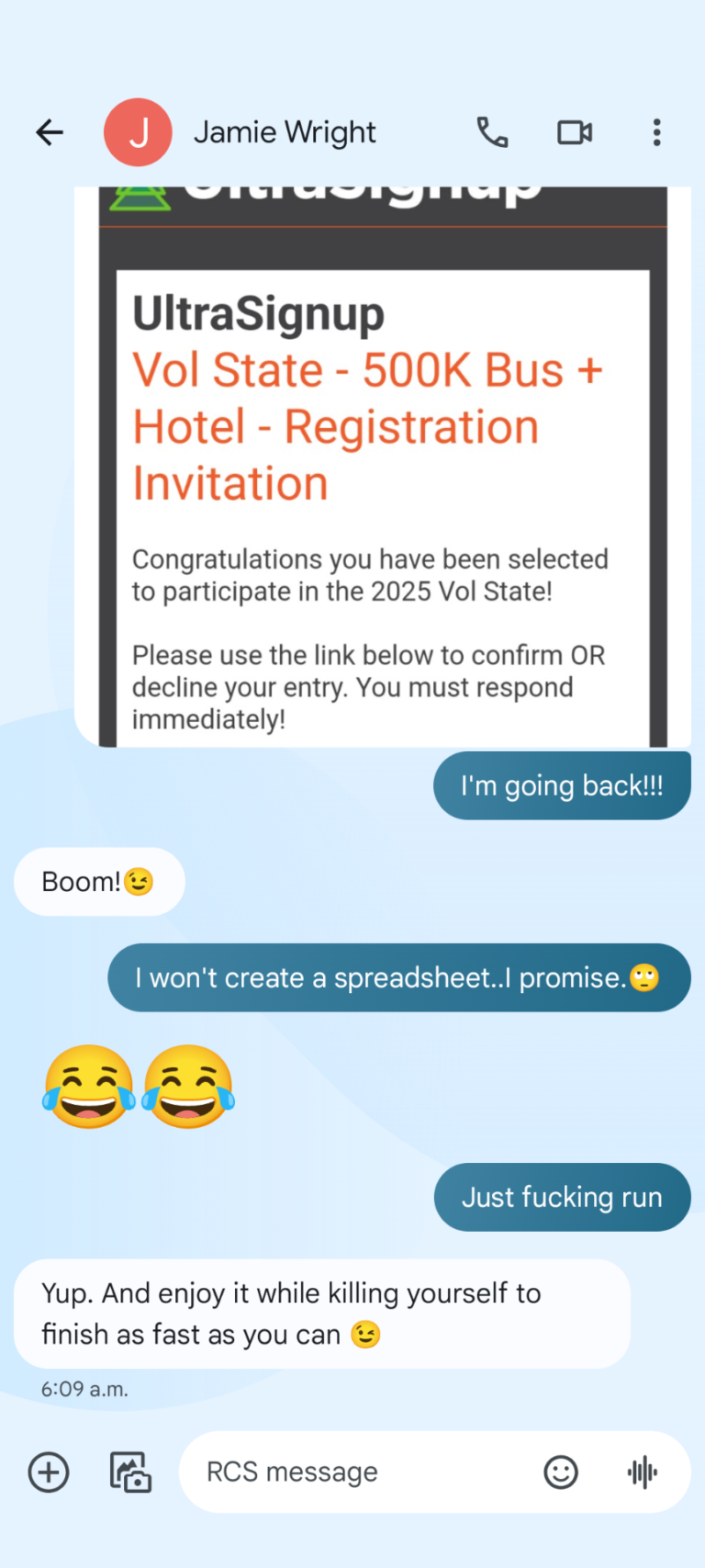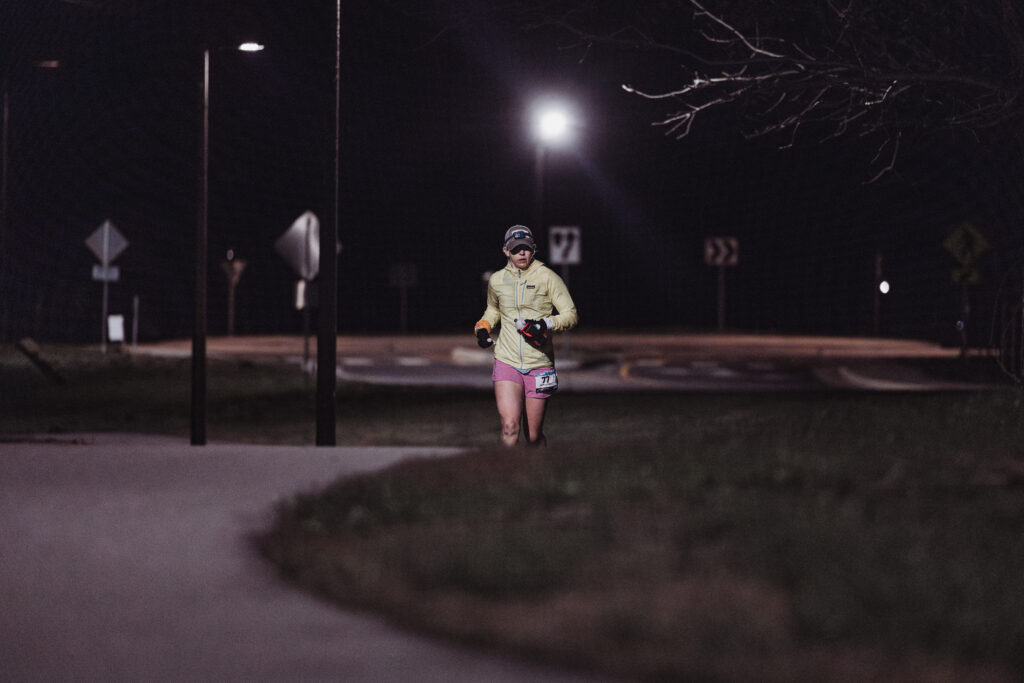I woke up alone in a hotel in Kimball, Tennessee, wearing only a Walmart t-shirt and underwear. My salt-caked shorts and sports bra were crumpled in a heap on the floor. Nearby, the only food: a warm bottle of Mountain Dew. On the table: scissors, blister bandages, a tube of Desitin, a Timex, duct tape, and the scattered remains of my race kit.
Every muscle screamed as I reached for my phone. I checked the Vol State Facebook group and saw the latest semi-daily update from Laz—a poetic snapshot of the race.
This time, it was about a woman who had chafed through her shorts, fallen and blackened an eye, blistered, burned, bitten by a dog, and now sat sobbing on a curb outside a gas station. He wrote about how the days of a journey run earn their own names.
That woman was me.
This was my second Vol State finish. I didn’t crush it like I planned. Instead, Tennessee served up a different challenge—less about speed, more about survival. Less grind. More grit.
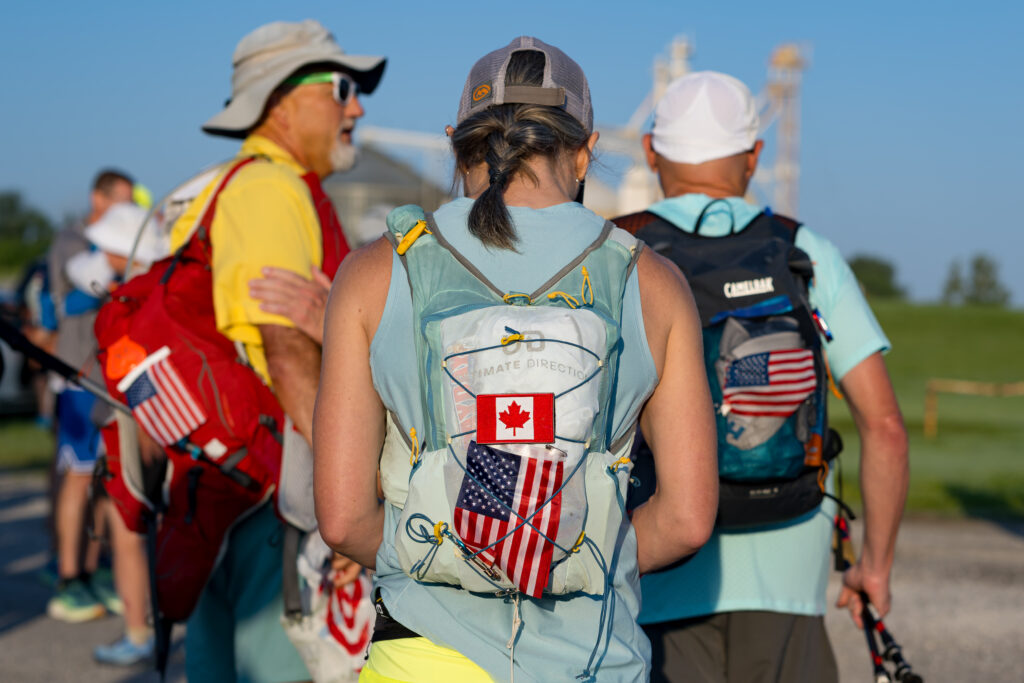
The Last Annual Vol State Run
The Last Annual Vol State Run (LAVS) is a 314-mile odyssey across Tennessee, brushing five states along the way. The race begins in Dorena, Missouri, with a ferry crossing into Hickman, Kentucky, before hitting Tennessee at Union City. From there, runners traverse a relentless mix of four-lane highways, where transport trucks create a constant wind tunnel, and narrow, winding roads demand a careful dance between guardrails and speeding pickups. As the finish nears, the route climbs up Sand Mountain, passing briefly through Alabama before ending in Castle Rock, Georgia.
Held in the peak of July heat, Vol State is as much a battle against the elements as it is against the miles. The weather is unpredictable—oppressive heat, sudden storms, and suffocating humidity are all part of the challenge.
But what truly sets Vol State apart is its culture. There are no official aid stations, no pacers, no medals—just a bumper sticker at the finish. Runners, whether crewed or self-supported, must rely on their own resourcefulness to navigate highways, backroads, and sleepy southern towns. Convenience stores become oases, church porches turn into beds, and gas station ice machines offer fleeting salvation from the relentless Tennessee sun.
Vol State isn’t just a race—it’s an odyssey that breaks you down, builds you back up, and keeps runners and walkers returning year after year.

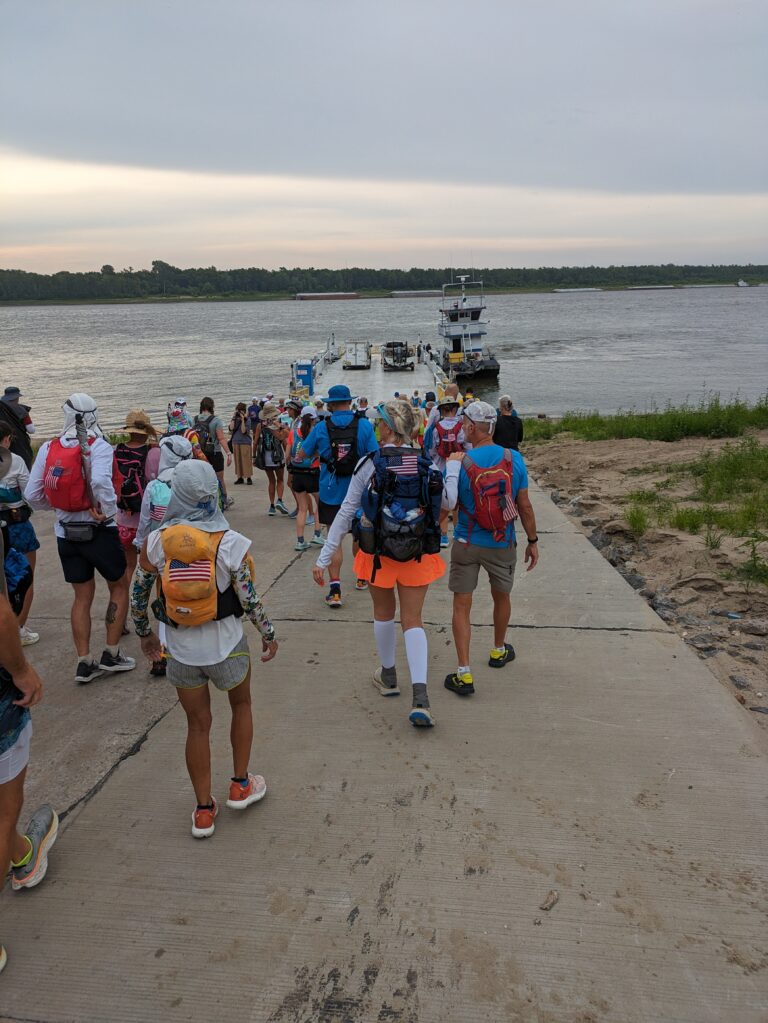
Day 1: The Day I was a Rockstar
Durango Missouri to Lexington, TN: 87 miles
later she fell
skinning up her leg and receiving a black eye.
– Lazerous Lakes, 144 h Vol State Update
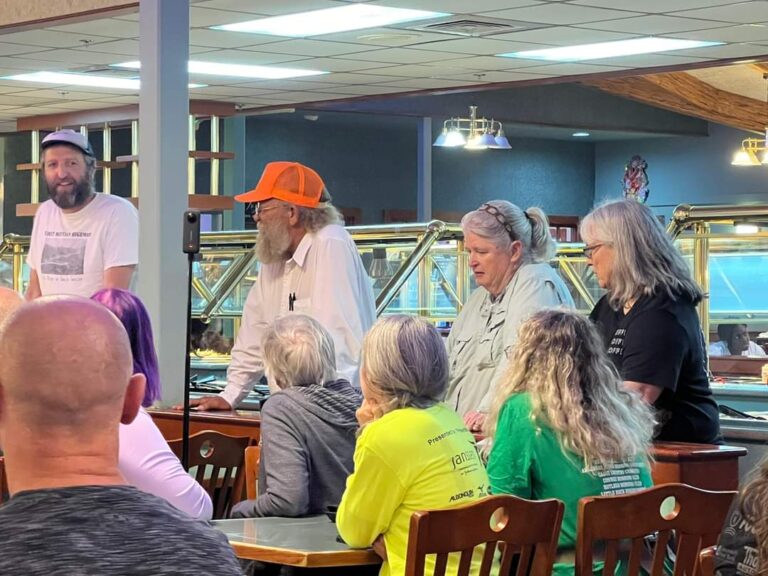
7:00 AM, we boarded the ferry in Hickman, Kentucky, to cross over the Mississippi River to Dorena Landing, Missouri. Once across, we climbed a short hill, just past a hydro pole, and waited for the ceremonial 7:30 AM cigarette lighting. Sound familiar?
The race director? The same man behind the Barkley Marathons and the Backyard Ultra. But this race had been on my radar long before he became a cult figure in the ultra world.
After the cigarette was lit, we got back on the ferry and returned to Hickman.
120 runners stood on that ferry, about to begin a 314-mile journey. The mix of people was as varied as the outfits they wore—baseball caps or sombreros, short shorts or compression tights, plaid hiking shirts or tank tops. Some carried small, efficient packs. Others looked packed for the Appalachian Trail. All ages, all sizes, all experience levels—runners and walkers, virgins and veterans.
I stayed quiet on the return ride, knowing many of these faces I would never see again—at least not this year.
As I got off the ferry, I moved to the front of the pack and eased into my all-day pace. Hickman, the first of many small towns I’d travel through in the days ahead, reminded me that small-town Tennessee is not small-town Ontario. Many shops were closed and houses run down—ghosts of what once looked like a vibrant community.
A police car crept slowly down the road with its lights flashing. It ended up escorting us out of Kentucky and to the Tennessee border. That was new—I didn’t see that last year. I felt a bit safer this time, with the police helping to alert the early morning traffic. Definitely not something ordered by the race director. Too polished. Too official.
As the day unfolded, I found myself leapfrogging with the lead runners. Each pass came with a brief exchange—runners sharing small talk before settling back into their own rhythm.
“Any word of advice?” asked a young man from New Hampshire, falling into step beside me.
“Take the time to take care of yourself,” I told him. “It’ll pay off later.”
Little did I know how much I’d need to take my own advice to heart later on.
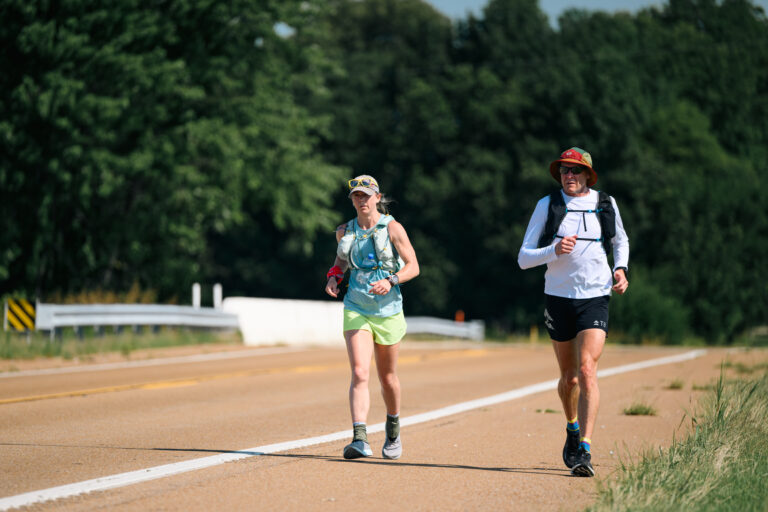
24 hours earlier, we were loading a bus at the finish line in Castle Rock, Georgia, for a 500 km drive across Tennessee. The journey felt like summer camp. Many knew each other from races across the U.S., swapping stories and catching up. Others, like me, stood quietly, hoping for someone to talk to.
We drove the race course in reverse. I already knew what to expect—it was my second time on this bus—so I drifted in and out of sleep, podcasts in my ears. Those few hours were likely the last decent sleep I’d get for days.
The day ended with a race briefing at a Chinese buffet in Union City, followed by a night in a dingy hotel. The next morning, it was back on the bus for a ride to the ferry.
The day unfolded with a mix of highlights. In one town, high school cross-country runners surprised us by lining the sidewalk, cheering us on, and handing out water. Later, Laz commented that this is the true spirit of Vol State—the unexpected support from locals.
More road angels appeared sporadically, offering treats in exchange for a bit of conversation. A few were familiar from last year—like the older gentleman with an industrial fan set up on his lawn to cool runners down, and a woman just a few miles later with a pop-up tent, collecting signatures and addresses in her notebook. These angels were lucky to catch most of the runners within a single day, before we started to spread out or drop off.
The Shoulders
“The shoulders are so narrow. It’s difficult running against the traffic on them,” remarked the lead female as we crossed paths.
“Don’t worry, you’ll harden up soon. It won’t bother you,” I replied.
Tennessee shoulders are infamous—either narrow or non-existent. The highways can be generous, but on the back roads, you’re lucky to get a foot. Often, it’s just the white line followed by a steep ditch. Last year, during the first few hours, I kept moving aside for every approaching car or transport, no matter how wide the road. But as the days wore on, it turned into a game of chicken.
They’ll move out of the way, I told myself.

That pattern continued through most of the day and into the night. I spent a good stretch leapfrogging with the lead woman’s husband. There was some light-hearted joking and regular check-ins about how she was holding up. From the start, I knew I wouldn’t keep up with her—not because of speed, but because of her incredible power hiking skills.
I was okay with that – I needed to run my race.
Just before the 50-mile mark, I stopped briefly at the Gleason Fire Department for some much-needed TLC. They had everything—shade, chairs, water, pizza, showers, even air mattresses—but I didn’t linger as long as I should have. I told LAZ and Carl how great I felt, and this Canadian had no issues with the Tennessee heat. I wanted to ride that momentum. I was aiming for over 50 miles by the 7:30 PM check-in.
A few hours later, the 12 update was released on the LAVS Facebook Group:
“meanwhile, up front a race is going on.
as with any first day there has been a lot of shuffling.
by mid-day chris varnadoe, paul (festus) hagan, and addison hendricks had moved to the front.
matthew bird was not far behind,
along with michelle leduc and shawna wendtlandt leading the women.”
[…]
“leduc and wendtlandt had both moved up and were running strong races as the day began to fade.”
– Lazerous Lakes, 12 h Vol State Update
I made it in the poem!!
From Peace to Pain: A Night on the Edge
As night set in, I was ready to ride the cooler temperatures and push through to morning. The stretch out of Gleason toward McKenzie was beautiful—open fields bathed in twilight. As darkness deepened, the world around me went to sleep. I ran through the quiet streets of small-town Tennessee alone, the silence broken only by the occasional passing car—heading who knows where at 2 AM.
The connection between towns was a wide, four-lane highway. Peace would settle for a moment, then shatter with the blinding lights and roar of a transport truck. Occasionally, I’d catch a distant headlamp flickering—either ahead or behind me. Depending on where my mind was at in that moment (and trust me, emotions swing wildly in this race), those lights either gave me hope or stirred panic.
It was a night of leaning fully into discomfort, not so much from running but of shedding the comfort and luxury of “normal” life and stepping into something raw, feral even. Just me and the road carrying everything I needed for the next few days. I’d stop, rest, eat and sleep whenever and wherever I wanted or could.
And then, on the road to Huntington, it began: the burning. That familiar sensation. A subtle irritation in my inner thighs and groin. Just a hint of burning at first, but I knew better than to ignore it. The first sign of trouble had arrived. It was time to follow my own advice: take the time to take care of yourself.
Down there.
Every time I peed, I dropped to my knees in pain. Literal pain. It took minutes to collect myself, to breathe, to stand. I’d start again with a bowlegged shuffle, then ease into walking, hiking, and eventually running. Panic crept in. This wasn’t something that usually gets better on its own.
The momentum I’d built was gone. I had to deal with this now or risk it getting much, much worse.
I reached for anti-chafing cream. Nothing. Then I tried Gold Bond—only to realize too late that it was foot powder. The cooling agent lit me on fire. It made everything worse.
Just as I finally started to find a groove again—bam. I tripped. One of those slow-motion stumbles where it feels like you might recover, until gravity finishes the job. I hit my knees and palms. No big deal—I’ve taken dozens of falls before (have you seen my knees?). But this time, my right cheekbone slammed into the concrete.
I lay there on the sidewalk, stunned.
And in that moment, I decided the race was done.
I wanted to quit. I wanted to go home. I wasn’t even 24 hours in, and everything was falling apart.
My original plan had been to run straight through the night to Lexington without stopping. Instead, I found myself breaking apart more and more. A 20-minute rest at a picnic table outside a municipal building. An hour lying on the steps of a church. I just didn’t want to hit the road again, the pain in my groin increased with each passing mile.
It was a slog—from Huntington to Parkers Crossroads.
I watched my well-laid plans slip away, unravelling right before me. And the worst part? It was just Day One.
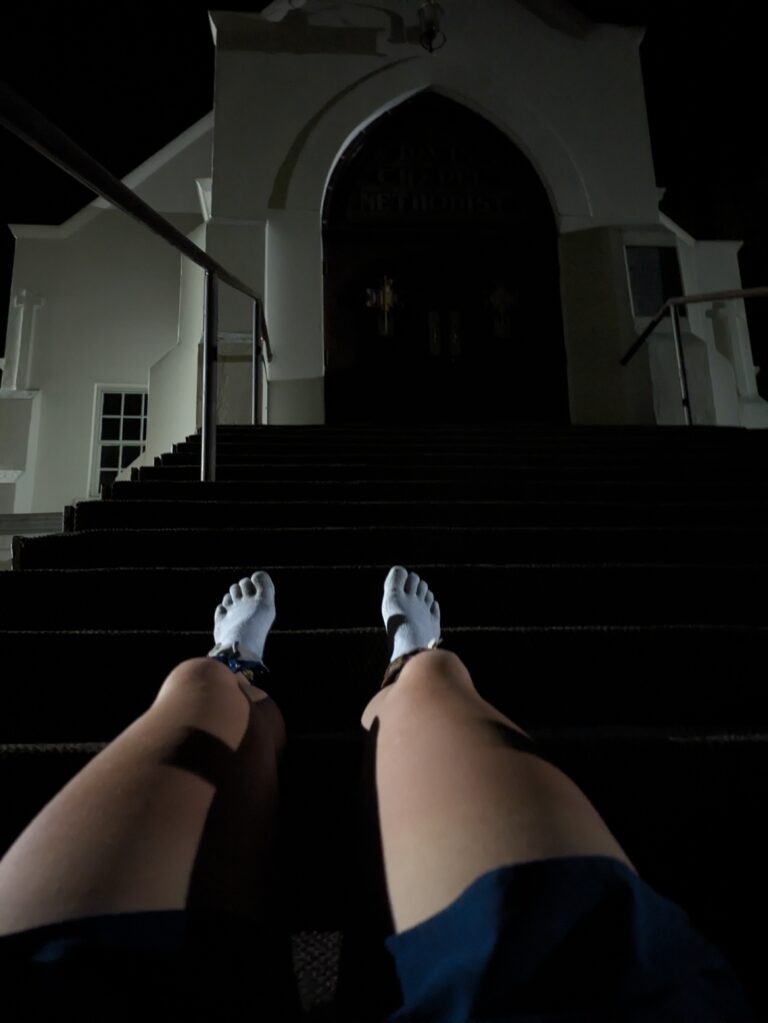
My Plan
My plan? Simple: hit 100 miles in 24 hours. Get to Lexington. Rest. Repeat. Last year, I hit the 100-mile mark after 30 hours, slowed down by too much walking at night. If I could keep running until sunrise this time, I’d reach Lexington by morning. There were cots at a church in town and a school at the 98-mile mark where I could grab an hour or two of rest.
From there, I aimed to run 50 to 60 miles as much as possible each day. I analyzed previous women’s sub-5-day results to identify key rest spots. Breaks would be 30 to 60 minutes at angel stops or in towns.
I planned two-hour overnight rests wherever I could.
If I averaged a 12-minute-per-kilometer pace between running and walking, I’d be in a good spot—enough of a buffer to secure a sub-5-day finish.
But as I put the plan together, I fully understood the nature of this race. Running 314 miles is a massive undertaking—both spatially and temporally. A lot can go wrong. A stubbed toe, a blister, or even the lingering effects of Hurricane Beryl could throw the entire plan out the window.
Little did I know: Vol State doesn’t like plans at all.
shawna wendtlandt has taken the lead among the women
and is just behind hendricks.
michelle leduc is 4 miles behind her.
stephen redfern has emerged from the chase pack for now
and is right behind leduc.
– Lazerous Lakes, 24 h Vol State Update
🎵 Ba-da-ba-ba-chaffed… I’m not lovin’ it. 🎵
At sunrise, I was slumped in a McDonald’s dining room in Parkers Crossroads—coffee in one hand, a breakfast sandwich in the other, and a bottle of baby powder sitting on the table like some kind of talisman. I was trying to figure out how to salvage the run—and maybe a little of my pride—when Eman, a fellow Canadian and 2023 Vet, rushed in to grab food for the runner he was crewing.
He spotted me hunched over my coffee.
“This might sound weird,” he said, lowering his voice, “but try KY Jelly. It worked for a runner last year.”
Then he was gone—torn between wanting to help and knowing he couldn’t. He was a crew. I was on my own.
I should have known better. I’ve battled chafing down there before—Eastern States in 2016, and even last year’s LAVS. Back then, I got through it by turning my shorts into a skort and staying dry with liberal, regular doses of baby powder. It wasn’t pretty, but it worked.
I liked my breathable Lululemon running shorts with the liner. I’d debated packing tight shorts instead—they were less prone to chafing but felt too hot during training runs in the heat.
I hated Past Michelle in that moment. I hated her for holding the tights in her hand on Tuesday morning and then deciding to leave them behind—for more room, for less weight.
Eons ago, when things were still logical.
Day Two: The Day of the Chafing
Lexington to Linden TN: 40 miles
Total: 127 Miles
on day 2 she had gotten extreme chafing
so she stopped at a store that had only mens boxer briefs underwear.
she needed something so she bought them
cut the liner out of her shorts and went on with mens underwear hanging out the leg.
– Lazerous Lakes, 144 h Vol State Update
The trek from Parker’s Crossroads to Lexington was long, broken up by two extended stops at angel stations. At one, I lay spread-eagle in front of a fan, trying to dry my shorts and soothe the burning until someone could dig up some cream. No shame here.
That morning in Lexington turned into a mission—a hunt for a bottle of “sex gel” and a pair of underwear that could protect my raw inner thighs. I veered off course to a Dollar General. No women’s boy briefs in sight. I scanned the men’s section: cotton boxer briefs, size Medium. No Small anywhere.
I’d wore my breathable Lululemon shorts to stay cool, but now here I was—desperately needing exactly what I’d tried to avoid: tight, suffocating shorts and cotton underwear.
Holding my breath, I asked the clerk, “Do you have a change room? I’m buying the shorts. I just need to change into them.”
After checking with the manager, they offered me the staff washroom. Surgery on my shorts complete, cleaned up and lubed up, I stepped out as a new person. I explained the situation to the clerk and manager—of course, they had no idea what LAVS was or why a “freakshow” dirty, half-broken runner was passing through town.
Leaving Lexington, I spotted a man taking a photo of me—Bob Hearn, screwed-and-crewed record holder. He’d been visiting family in Nashville and decided to check in on the race. When you do LAVS, you become part of the family.
I cried. Just so grateful he came by to say “Hi”.
“I’ve had bad chafing before,” he said. “Squirrel Nut Butter saved me.”
I nodded— as if I could find them at another Dollar General or gas station.

Later, Laz and Sandra rolled by. We were spread thin on the course by then. Laz spotted my skinned knee, though the shadow of my cap hid the black eye. I showed them the hacked-up shorts and men’s blue boxer briefs. Laz laughed.
That was the last time I saw them until the Rock. They were probably chasing the leaders now, way ahead of me. I wasn’t part of that group anymore.
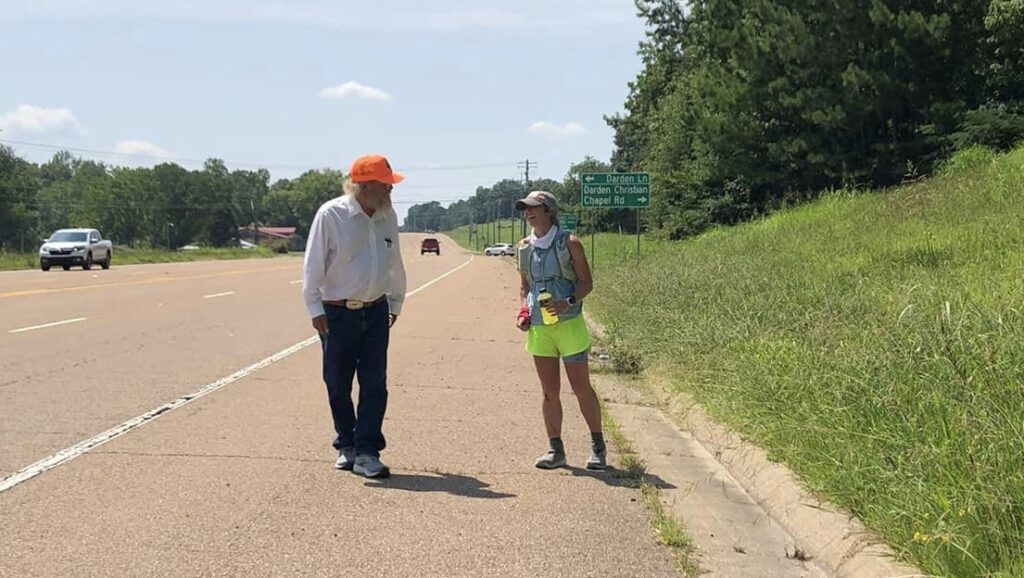
From Chasing Splits to Chasing Sleep
I hit Pin Oak School around the 30-hour mark. I was behind schedule but still within reach of last year’s time. I had budgeted 30 minutes, but it took me an hour. I cleaned up and elevated my feet.
Same story at Parsons—another angel stop. I sat quietly, hiding from the blazing sun, soaking in the calm energy of the Peachman’s blue healer and the steady hum of the fan. Not much conversation this year. Just a quiet moment of self-pity. Another runner broke the silence by expelling the contents of his stomach upon waking from his nap.
As my target time slipped away, so did my urgency. I told myself those extra minutes at aid stations would pay off later. But really? I was justifying. I’d already given up.
After the 7:30 PM check-in, I went to another stop, feeling the full weight of falling behind my 2023 splits. I collapsed into an antigravity chair and let exhaustion wash over me.
The cicadas buzzed. Runners passed. I slept and slept. Again, the 30-minute budget became 2 hours.
The lead was long gone—but I didn’t care. But looking at the 36-hour update later on I was still running strong but I just didn’t see it. Matthew was crewed, and I was still on his heels at that point:
matthew bird was about 7 miles back,
just reaching the tennessee river.
he has been running strong for the past 24 hours.
michelle leduc is about a mile behind him.
– Lazerous Lakes, 36 h Vol State Update
When I finally stirred, it was time to face the brutal haul to Linden. Alone, in pain, hallucinations starting to kick in badly. The white line on the road lifted and began to wave in the breeze. Taking Laz’s advise during the briefing, I took a 10-minute nap on the church parking lot. On the ashapalt using my pack as a pillow only staying long enough before the chill kicked in.
Once in Linden, I headed straight to another small sanctuary offering mats and towels to worn-down runners. I found a chair, propped my feet up, and passed out again. One, two maybe three, hours went by.
When I finally emerged, the sun was already high. Last year, I had left Linden before dawn, the cool darkness still blanketing the roads. Now, I was trailing behind last year’s pace, and the gap kept growing. I’d budgeted two hours of rest that night—it was well over five.
I couldn’t shake the thought: this is turning into a complete shit show.
But despite everything—the chafing, the falls, the heat, the sleep-debt spiral—I had no choice but to keep moving.
Quitting wasn’t in my vocabulary… not yet.
Day 3: The Day of the Blisters
Linden to Columbia, TN: 52 miles
Total: 172 Miles
on day 3 she developed blisters that left her limping
– Lazerous Lakes, 144 h Vol State Update
As I made my way out of Linden, an elderly man slowed his truck beside me. “Just heading out to grab some ice,” he said. “I have a spot about ten miles down the road.” I recognized him immediately from the previous year. When I finally reached his carport, he and his wife sat with me while I rested and engaged in conversations. They truly enjoyed this event and meeting new and returning runners.
A few miles before, I passed a young couple sitting on their porch, curiously watching me shuffle by.
“What’s going on? Do you want some water?” the man asked. Then ran inside to grab me a bottle.
I gratefully accepted and explained the race, distance, and quirks.
As I started to head back out, he called after me, “I’m going to set up a cooler, water, and a chair!”
I’m unsure if he ever did, but I hope so—not just for the runners, but for him. There’s something special about offering a simple gesture—a place to rest or a cold drink—and becoming part of something bigger.
His story echoes the origin of so many Road Angels along the course. The “carport” man and others told me something similar. What starts as curiosity about these strange, determined people running through small-town America often becomes a yearly ritual—one rooted in kindness and connection.
They appear out of the blue—offering water, ice, a chair in the shade. A Gatorade on a blistering day, a kind word when you’re breaking down. They do it not for recognition but because they care. Vol State wouldn’t be the same without them.
The Blisters
Forever ago, back at the hotel in Union City on the morning of the ferry, I slipped my shoes on and immediately felt something off on my left foot—like something was bunched up under the ball. I took the shoe off and checked. Nothing. Odd.
I double-checked my taping. I’d finally mastered the process. My big and second toes were always prone to blisters, so I made sure they were well-covered. The sides and balls of my feet were building up calluses, so I added an extra strip of tape across the ball for good measure.
Injinji liner socks went on over the tape, then hiking socks. Still, that strange sensation lingered. But the bus was leaving—I didn’t have time to dwell on it.
The discomfort came and went. I tried everything—peeled off the tape, changed socks, slathered Gold Bond, massaged the foot. Still, that weird, nagging feeling wouldn’t quit.
By the time I reached the city limits of Hohenwald, I was limping. I stopped at another angel stop, pulled off my sneakers, and there they were. Two blisters, side by side, smack on the ball of my left foot. I tried to drain them, but it only made things worse. The pain was sharp and deep. Walking hurt.
I hobbled into town, knowing I had to stop and clean up. Between the blisters and the chafing, I was done. I found a hotel and inquired about renting a room for a few hours. The staff didn’t bat an eye—they’d seen plenty of us over the years.
“Man, you must be making a killing with us paying full price for a room just for a few hours, only to turn it over to the next one,” I joked at the front desk.
Back in the room, I peeled off my clothes, rinsed them in the sink, and hung them to dry. After showering, I changed into a clean pair of briefs and a cotton T-shirt, then set my timer for a one-hour nap. I gave myself another thirty minutes to patch up and repack. I protected my blistered feet with a donut-shaped blister bandage, Desitin Cream, and secured it with KT tape. That and clean underwear and an hour of rest. That was all it took to feel ready to tackle the long 50 km stretch to Columbia.
In the middle of it all, I snapped a bathroom mirror selfie—cotton tee, men’s underwear, no façade. I posted it in our running club’s Facebook group. They were watching the race from home, checking in every twelve hours, always praising me for being strong, tough, and amazing.

But in that moment, I didn’t feel strong or tough—I felt like I had failed.
I didn’t post it for accolades. I posted it to remind them I was human. That I wasn’t the person they thought I was. I was struggling, just like anyone else. And somewhere in that vulnerability, I realized something: maybe they didn’t need a superhero. Just someone out there doing their best.
The 30-mile stretch toward Columbia is long. Last year, I tackled it during the day—a hot, grueling hike to Hampshire, followed by a sleep-deprived march to Columbia. The veterans know better: they camp out in Hohenwald and delay departure until evening, when the sun begins to dip. This year, the timing worked in my favour. I left Hohenwald around 6 PM, just as the heat began to fade.
This stretch is called “the desert”—nearly 50 kilometres of highways and narrow roads, no stores, and no certainty of help. A few coolers were scattered along the way, and there was one tent with some lawn chairs.
Leaving Hohenwald, something shifted. I flew through—at least it felt like it—that 15-mile stretch. I felt strong. I felt fast. I felt relaxed. For the first time in days, I was enjoying the run. I felt like I did on Day One—like a rockstar.
When the Fence Is Your Only Friend
Just as I turned off the highway onto the narrow, winding road toward Hampshire, a new threat reminded me I was deep in Vol State territory—dogs. Not the friendly, leash-walking kind. These were Tennessee dogs. Mean and territorial.
The silence of the night was shattered by violent barking. The sound was guttural, furious. I froze for a second, heart thudding. Then came the rattle—metal on metal—as they slammed against a chain-link fence.
I couldn’t see them, but I could feel them—smelling me, watching, waiting. I held my breath and kept moving, praying the fence would hold.
When I rolled into Hampshire, I bypassed the fire station aid station, assuming there’d be more options ahead.
There weren’t.
So I stopped at a convenience store, laid down on the concrete patio, propped my feet up on a picnic table, and rested.
The sky stretched above me—full of sound and silence: the hum of cars, the buzz of cicadas, the rustle of animals, the occasional footsteps of someone passing by. I was done. Drained. My stomach was in knots. My body ached.
I rested my head on my pack—everything I needed to survive the next few days. Some of it, I knew I didn’t really need.
But somehow, in that moment, it all faded. It was just me, alone, nothing to focus on but getting to the rock. No computer, no commitments, no deadlines. I was at peace.
Fear
The roads leaving Hampshire were narrow, winding, and hilly. Somewhere out there, I passed a house party—voices and laughter drifting through the dark. I couldn’t see them, didn’t want to. I focused on one thing: moving forward.
A motorcycle buzzed in the distance. The sound grew louder—fast, too fast. I held my breath as it passed, a blur of noise and tension. Then came the cars. I moved to the shoulder, lowering my headlamp to avoid blinding the drivers.
Please don’t stop. Please don’t run me over.
I always say this race doesn’t scare me. Most of the time, that’s true. But sometimes, fear shows up anyway—tight in your chest, whispering worst-case scenarios in the dark.
And then it passes.
Because what’s the alternative? Sitting in your basement, watching the world go by on a big screen?
Out here, I was alive. Even in fear. Even in pain. I was on a journey, creating my adventure instead of watching someone else’s unfold.
As the miles racked up, the sense of adventure gave way to exhaustion. My focus shifted from progress to finding a place—any place—to rest. A lawn chair. A hammock. A driveway. The 25 km from Hampshire to Columbia dragged on, longer with every step.
I finally death-marched into Columbia at sunrise. Joggers were out for their Sunday runs, cooling down in front of a coffee shop—fresh, smiling, untouched by the night.
Meanwhile, I was a salt-streaked wreck in men’s underwear. They didn’t even look at me. Not a word. Not even a glance. No offers of water.
“F’n idiots,” I muttered. “How can you enjoy such a wretched activity as running?”
Another hotel. Another few hours. I checked in, crashed for an hour, and hit snooze again. I didn’t want to go back out. Based on last year, the coming day was going to be a scorcher.
Desperate Measures
It’s hard to explain why I love running 100 miles—especially when it becomes 200 or more. It’s not the finish line. It’s the unknown that comes after the start—the chaos in between.
Vol State isn’t just a test of strength—it’s a test of adaptation. You must be prepared for anything. You have to be resourceful.
The men’s shorts I wore were a mistake. That extra fabric for men? Useless. It made my inner thighs raw and swollen. I grabbed my KT tape, thinking that covering it would help. I sprayed tincture of benzoin on the wound so the tape would stick—and dropped to my knees from the pain. It was searing. But I needed that tape to hold.
Last year, I ended up cutting the crotch out of my shorts and turning them into a skirt. It worked. My toes were swollen, blistered—I cut holes in my shoes just to give them room to breathe.
This year, I came more prepared. Zip-lock freezer bags for ice. A tiny first-aid kit: K-Tape, scissors, a jackknife, alcohol wipes, Wet Ones, Trail Toes cream. A buff. A battery pack with all the right cables. And Desitin: my miracle cream, my sunblock, my foot rub. It ruined everything it touched, and the smell still haunts me—but it worked.
Because nothing strips you down to your rawest self like running through the night on blistered feet, with your skin on fire, miles away from comfort, knowing you still have days to go.
It’s not about medals. Or social media kudos. It’s the brutal beauty of figuring it out—solving problems with duct tape and desperation, and continuing when everything tells you to stop.
That’s why I keep coming back.

And when you need it: Adjusting Expectations.
When runners come to the vol state,
they usually come with expectations.
The vast majority of them find that those expectations
are optimistic!
days 2 and 3 are when these expectations are either:
- adjusted, or…
- allowed to de-rail their race.
– Carl Laniak
“Thanks, Carl. I needed it,” I commented on his Facebook Post. 36 hours later, Carl remarked on that comment when I saw him at the rock.
Day 4: The Day I was burnt to a crisp
Columbia to Wartrace, TN: 52 miles
Total: 231 miles
on day 4 the sun burnt her to a crisp
– Lazerous Lakes, 144 h Vol State Update
The trek from Columbia to Lewisburg was brutal. The sun beat down relentlessly, the air heavy with miles still ahead.
I passed the Bench of Despair—the one with past Vol State runners’ names carved into it. Everyone stops there for a photo. Not me. Not this year. I couldn’t muster the energy.
Then a car passed and pulled over. A boy jumped out, running toward me with a lemon popsicle. I cried. Maybe it was the cold, or maybe it was the joy on his face as he handed it over. That small act of kindness shattered the exhaustion I’d been dragging all day.
Just like most of the race, the stretch from Culleoka to Lewisburg was relentless. Open road. No shelter. The sun beat down, and I roasted—overheated, unraveling. I was dying.
In the distance, I saw a pylon at the end of a driveway. As I got closer, I prayed the sign leaning against it was meant for me—a safe place to rest, even without shade. The sign pointed runners toward a cooler tucked in a ditch. I didn’t go there. I flopped down right on the driveway. Pulled off my shoes and socks—roasting from the heat of the asphalt—and cried.
I couldn’t bear going on.
The Husband
I called my husband a lot during the race. I told myself not to call when things were terrible, but of course, I did.
“It’s hot. This is so hard. I want to quit.”
“That’s okay if you do,” he said. “I’ll respect any decision. I can come get you.”
His calm response made my blood boil. It felt like he wanted me to quit—so he could return home to the shed and backyard. I hung up, furious.
That anger became fuel. And I started to run again.
He didn’t understand what it meant to set a goal like this. To give everything, even when your body is wrecked and quitting feels like relief. But I did. And I wasn’t stopping.
The Coach
Later that afternoon, I stopped at a convenience store/diner for a chocolate milk and to charge by phone. I did the math. Could I finish in five days? Match last year? The numbers didn’t lie. I walked away more frustrated than before. I was failing.
Then Derrick called.
I thought Sean had reached out to him, but it was just a coincidence. I had sent him a screenshot of a Facebook post the day before—proof I was struggling.
As transports roared past and thunder was rolling in the distance, I vented—everything that had gone wrong, over 100 miles still ahead. Another day, maybe more. Derrick listened, then said what I needed to hear: I was fixating on the Rock. I needed smaller goals.
“Town to town,” he said. “Angel station to checkpoint.”
Suddenly, the impossible felt manageable.
We talked for what felt like hours—though it was probably only 30 minutes. It was exactly what I needed. He reminded me that chaos is part of this race. That I was doing well, even when it didn’t feel like it. And I needed to hear that.
By the time I rolled into Lewisburg, I felt lighter. Not physically. But emotionally. The anger had faded. I wasn’t thinking about the end. I was thinking about forward. One small win at a time.
Shelbyville and the Blurred Days
Last year, I was warned to pass through Lewisburg and Shelbyville during daylight. This time, I beat the 7:30 PM check-in at Lewisburg and reached Shelbyville just before sunrise.
I pushed through the 36 km stretch between the towns, resting briefly at a few spots: a cot, the asphalt lot beside a maintenance building, and a sweaty mattress abandoned at the entrance to a field.
Nighttime was my downfall last year, but this year, the cool air and silence kept me moving.
Even in the early light, Shelbyville felt uneasy—quiet, but grimy. I stopped in front of City Hall, the only place that felt safe, to patch my feet and watch the sunrise. It might have been Monday. Maybe Tuesday.
The days had no names anymore—just distance.
Time had melted into miles. There were no Monday mornings or Saturday nights—just stretches of road between towns, the rhythm of feet on pavement, and whatever came next. The only thing that marked time was the pain: how long since the last blister check, the next angel stop, the rising or fading of the sun. It was primitive. And completely disorienting.
The key to finishing Vol State is to keep moving.
Last year I ran the bulk of the race with a fellow runner Tim. We kept each other honest. Run to the mailbox. Walk to the sign. Run to the base of the hill. That rhythm kept us moving – saved us.
This year, I had no Tim. Just an old-school interval watch, my GPS, and a plan: run five minutes, walk two. No logic—just something that felt doable.
When my brain needed a break from maps, I did math instead. If I had 10 km left, how many intervals would it take? I wouldn’t check the map again until I hit the last interval. The counting game kept my mind busy and my legs moving through the long, dark nights.
Day 5: The Day of the Dog Bite
Wartrace to Monteagle, TN: 44 miles
Total: 274 miles
on day 5 a dog bit the unskinned leg.
– Lazerous Lakes, 144 h Vol State Update
At the 7:30 AM check-in, I was sitting on a Road Angel’s front porch, patching up my feet again. There was no shelter from the sun. I was already dripping with sweat. This was going to be a hard day.
And it was.
In Wartrace, I bought a bag of ice. I filled my hydration bladder, a bottle, and whatever Ziplocs I had. One bag went on my neck, the rest in my hands. They didn’t last long – just past the outskirts of the town.
The heat was punishing more so than the day before. The sun felt like it was breathing fire straight at me. I had two choices: power hike and drag the day out, or risk running and overheating. I ran when I could—walked when I had to.
Somewhere along the way, I saw a road sign—three people standing nearby. I knew they were not real, but still I stared, half-disbelieving, unsure what was real anymore. I pushed on, praying I could make it to Manchester.
The World Kept Spinning—But I Was Just Trying to Charge My Phone
Once there, I made a beeline for Walmart and finally found underwear that actually fit. Small wins.
Of course, looking like the filthy mess I was – I got stared at, looked down upon by a mother and her daughter. Just like last year when another set saw me at a gas station with a large Sonic slushie strapped to my chest.
Before I left, I grabbed food at the Subway and asked them to charge my phone—it was nearly dead. Check-in time passed while I was still there, and friends watching from home started to worry.
“Did you hear about the assassination attempt?” the sandwich artist asked.
It hit me then—I had no idea what was happening in the world. My universe had shrunk to water, tape, and surviving the next mile.
Miles Apart, Never Alone—Kindness Shows Up Unannounced
Last year, I hiked this stretch in the heat of the day—brutal, exposed highway. This year, I hit it at night. Transports roared past like ghosts, their wind shoving me sideways. Each time one approached, I held my breath and dipped my head to keep from blinding them with my headlamp.
There was something eerie about it—how alone I felt, and yet how closely I shared the road with machines that could end everything in a second. I watched headlights appear in the distance like warnings, not promises. Each pass left me rattled but grateful. Still here. Still moving.
To stay sane, I leaned on my intervals. Just get to the next milestone. Then the next.
I made it to a Dollar General just before closing—grabbed food and electrolytes. I sat on the pavement outside, phone charging, legs outstretched, watching headlights flicker past like ghosts.
A car pulled in—two young guys. They slowed, stared, then sped off. My gut clenched.
Minutes later, they came back. Pulled up in front of me.
I held my breath.
“You’re one of those runners, right?” one asked.
“Yeah,” I said, cautiously.
He handed me two cold bottles of water. No questions. No lecture.
Just kindness.
Then they peeled off to find more runners.
That’s the beauty of Vol State.
If you check the maps, you’re never truly alone. Stop for 30 minutes, someone will catch up. By day five, there’s a stream of people all heading toward the Rock.
That night, I leapfrogged with a few guys. We’d trade words, spread out again. Never quite alone.
What’s One More Wound? Courtesy of a Tennessee Dog.
Just as the sun rose, I hit Pelham. That’s when I heard it: barking. Vicious barking.
I stopped running. Walked. Eyes straight ahead.
Small but vicious—circling, nipping. I sprayed water. They backed off… then came back, meaner.
One sank its teeth into my calf.
I kept moving. Spraying water at them. Behind me, someone yelled—at the dogs, or at me. I didn’t care. I didn’t stop. I didn’t look back. I didn’t want to chance a shotgun in my face.
When I finally got clear, I collapsed at the foot of a church. Lying on the ground, feet in the air, soaking in the quiet of 4:30 AM.
I checked the bite.
Should I get shots? I didn’t care.
How much worse could it get?
Not Quite Kimball, Definitely Not Nashville
Then came Monteagle. The climb was steep, winding and relentless. I hugged the shoulder, bracing for cars on every blind turn. A 45 minute grind.
At the top, everything was closed. Which meant a 500-meter out-and-back detour to a gas station McDonald’s for food and a bathroom. Even a few extra meters felt impossible.
Dragging myself inside, I saw a cop dealing with a rough-looking woman. Judging by the scene, she wasn’t a pillar of the community. We’re not in Russell anymore.
I hovered over my coffee, that dull weight of failure settling in again.
I should have been in Kimball by now.
No—Nashville.
Floating in my brother-in-law’s pool. Belly full of Mexican food.
Day 6: The Day I weeped on the curb
Monteagle, TN to Castle Rock, AL: 40 miles
Total: 314 miles
and now, on the morning of day 6
she sat on a curb in front of a gas station
dirty, haggard, hair matted, bruised and bloodied….
.
weeping.
– Lazerous Lakes, 144 h Vol State Update
I was 12 hours off last year—and, surprisingly, I realized it was a blessing. I got to see the towns and landscapes I missed running through in the dark the year before.
The road from Shelbyville to Wartrace rolled open and wide—quiet, golden, and briefly forgiving.
Tracy City, on the other hand, was sketchy as hell. I didn’t notice it at 1 a.m. last year—but in the daylight? I walked out feeling worse than when I entered. I stopped quickly in a park to recompose and clean up. For some reason, I really didn’t want to stay there any longer than needed.
The ascent up Monteagle in the morning gave way to a long descent toward Jasper that afternoon—perhaps six or eight hours, I lost track.
A brutal stretch along the highway, the sun just hammering down. Trying to break me. I stopped where of could find shade to cool down. Then—relief. A thunderstorm rolled through. It cooled me off, but left me drenched. And once the sun came back out, it was like stepping into a sauna. The heat and humidity wrapped around me again like a punishment.
What goes up must come down—five kilometres of downhill to Jasper. So I said screw it—I ran it like the final stretch of a road race. Didn’t care what it would do to my body—I just wanted to get it over with—five fast kilometres to chip away at the time to the Rock.
I paid for it. My feet were wrecked—I could barely walk.
The stretch to Kimball was a matter of pure survival. Hobbling, head down, a disposable poncho around my neck, trying not to cry, trying not to scream.
He Worries. I Run. Somehow It Works
As I rolled into Jasper, Sean called to ask where I was, so he could plan his evening. I was still draped in a crinkly disposable poncho, my feet throbbing with pain.
“I’m in Jasper,” I wailed, and then broke down into sobs.
He replied in that fake-soft tone he uses when he doesn’t know what else to say:
“It’s okay, I can come pick you up.”
“No,” I said through tears. “I’m just five miles from Kimbal. Fourteen from The Rock. I’m almost done.”
I kept sobbing. I let it all out—the pain, the exhaustion, the frustration—a mix of excitement, fatigue, and anger (mainly directed at him, once again).
Note to self: add don’t answer your husband’s calls when you’re at your lowest to the growing list.
Meanwhile, Sean was in Nashville, staying at his brother’s place, trying to keep himself busy. We’re different people in a lot of ways. I run—he doesn’t. I seek out these uncomfortable, uncertain adventures. He prefers home, the familiar rhythms of the work, backyard and shed.
He worries when I do things like this—probably more than he admits. And me? I get frustrated by that worry. I don’t want to live cautiously. I want to chase the hard things and see what I’m capable of.
He is caring and supportive, even when he doesn’t quite understand why I do this. And though he may grumble about my races, he still brags about them—to friends, family, anyone who’ll listen.
But in races like this—where I’m fully self-reliant—I breathe a little easier. Not because I don’t want him there, but because it’s simpler to carry only my own emotions.
Not Homeless. Not Abused. Just Vol State.
As I left Jasper – I stopped at a gas station looking for a disposable poncho – this one I was carrying was almost destroyed. I was unsure if the storms would continue into the night. None – of course, why in the heck was I thinking they’d have one? It’s a freaking gas station not MEC.
Exhausted and depleted I walked out the gas station and sat on the curb and cried. How am I going to survive the next 19 miles? A man pulled up and got out. “You okay?” he asked, gesturing to his eye. Oh, right. I guess mine was still black.
“Oh no, I am okay” Then explained to yet another local about the race. I reassured him I wasn’t homeless or abused—I just fell. Days ago.
Crossing the Bridge from Broken to Badass
When I reached Kimball, I grabbed a room at the hotel, knowing I’d collapse there when it was over. After a quick wash, I patched myself up and refuelled with chicken nuggets and a milkshake. It was all I needed for the last stretch—a “mere” 14 miles, but uphill and with my body utterly wrecked.
I set out under the cover of night, my feet destroyed from the descent into Jasper. Jogging was out of the question. I powered through the first few miles until I reached the Blue Bridge.
The Blue Bridge is the landmark of the race—the sign that you’ve made it. This time, it greeted me in the dark, its massive frame illuminated only by passing cars. I stopped, taking in the Tennessee River and lights along the shore, a place I had seen upstream just days earlier, past Parson.
At that moment, I reflected on my journey—the ferry ride, the endless roads, the towns I passed through, and the challenges I faced. I thought about her—the Michelle I used to see in the mirror. The one I struggled to like. She was shy, uncertain, and always second-guessing herself. She never felt like enough, even when she was trying her best.
Despite everything I’ve achieved, I’ve struggled to be proud of myself.
But then I realized: I ran across Tennessee—alone. I slept on the parking lot asphalt. I face heat, fatigue, and transports barreling down the highway in the dead of night. I walked through sketchy towns with little fear. Even after chafing that left my shorts bloody, a smashed knee, a bashed face, sleep deprivation, searing sun, and a dog bite—and I still kept going.
and sometimes it goes like this;
“i felt disappointed in my performance.
so many things went wrong….
.
but while i was crossing the blue bridge
i thought about how i had overcome so many difficulties
how i had solved so many problems,
and i realized that i had run a great race,
i just didnt record a good time…
.
and i felt like a badass!”
– Lazerous Lakes, 144 h Vol State Update
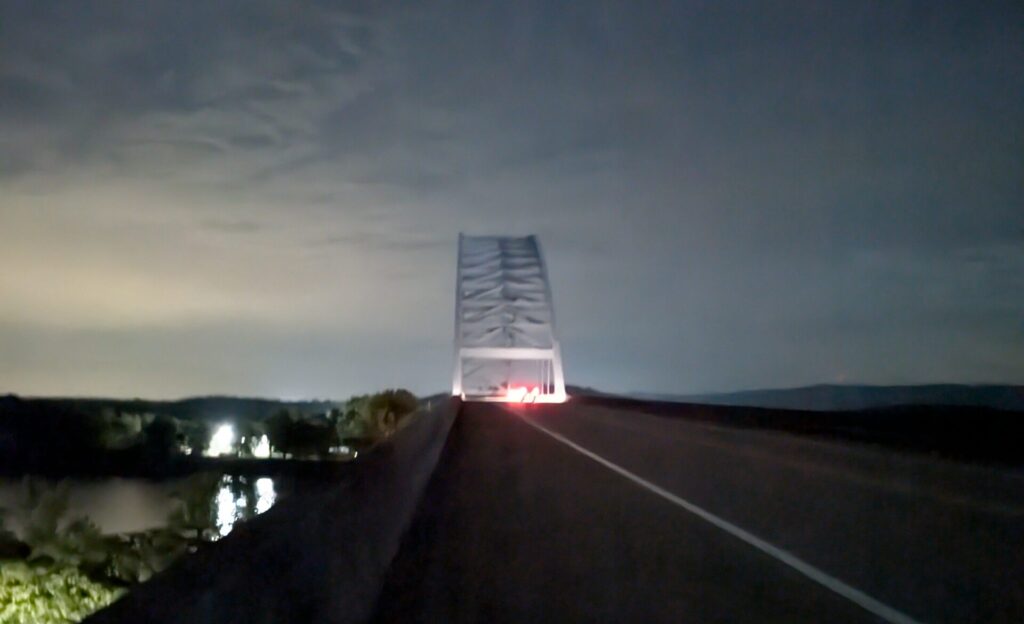
The Throne, the Rock, and the Road Behind Me
With that, I pushed on toward Sand Mountain. Then, as I hit the turn to the final ascent, I battled the final boss of the race: sleep deprivation. It hit hard, worsening with every step. I was so close to finishing, but I had to stop, sit on a guardrail, and recompose myself before moving my body forward. The middle of the night blessed me with little traffic, but my GPS seemed to mock me. Just 14 miles left. A couple of hours, in theory. But it felt endless.. Yet weaving across the road, frequent stops to shake off sleep, and sheer exhaustion made it feel endless.
Finally, I reached the Gate. The end of the roads and highways.
The final stretch to the Rock was a gauntlet—a road lined with white fences, a cornfield, and then, because it wouldn’t be LAVS without a twist, a trail through a bush. In classic Laz fashion, signs dotted the last mile or so:
“Just one mile to go.”
“Just one mile to go.”
“Trust me, just one more.”
At last, I saw the lone light of the tent. The finish was a stop sign and a rail perched at the cliff’s edge. I am sure I saw this from the base of the mountain hours ago. Touching the base of the sign marked the end.
I collapsed into the throne—a battered folding chair—as Laz, Carl, and Steve listened while I recounted the journey. Each story spilled out, one after another, met with laughter and nods of understanding. They shared tales of runners who had endured their own battles, each journey as unique and gruelling as mine.
Just before we got into the car to make the trip back to the hotel in Kimball, I looked up into the stary sky and said with sadness
“It look like there will be no more sleeping under the stars”
A grainy photograph and a quote captured the moment on the Facebook Group:
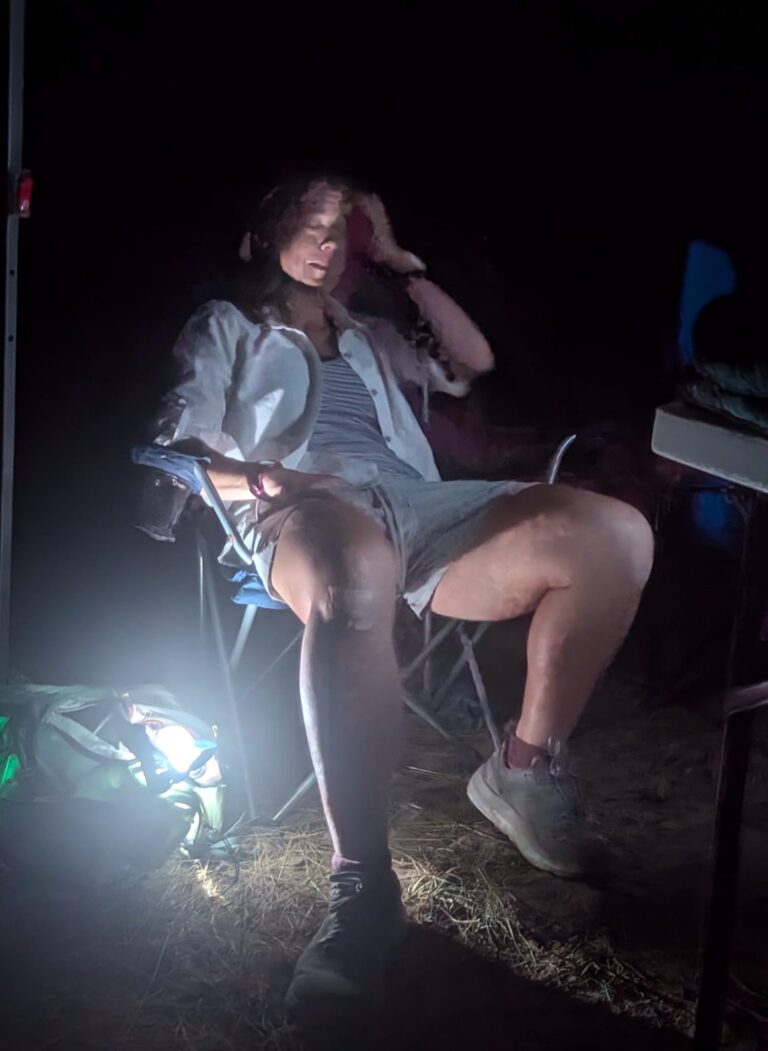
“Last year was great…this year sucked!….but then, after I crossed the bridge….It was so great! It took the whole way but I’m so glad I came back.”
The next morning, I woke to find I had become the focus of Laz’s latest Facebook post—a poetic tribute, written in his signature lowercase style. The leaders may have crossed first, but now the spotlight was on the runners in the back, the ones grinding out the miles, the ones with stories like mine.
The bumper sticker
Boston has their jackets. Western States—and most 100-milers—have their belt buckles. But finishing LAVS? You get a bumper sticker with “314” on it.
Driving through the streets of Russell or Ottawa, that number means nothing to most. Just another sticker on a car. But for those who’ve done the race, it means everything.
This is my second one.I was saving it for my next car. But after this journey, it belongs beside the first one.I earned it. I deserve it.

Epilogue: The return to reality
Days later, I feel a bit sad that my black eye, skinned knee, dog bite, and sunburn are healing. (The chafing and blistered feet can’t heal fast enough.) They’re battle wounds I’m weirdly proud of—like proof I didn’t just survive; I earned every mile.
I have trouble sleeping at night—thanks to the chafing, calloused feet, and legs that radiate heat. I hover in and out of sleep, haunted by dreams of running endlessly, the finish always just out of reach.
Work feels impossible. I sit at my desk, body aching, mind drifting. I cleared the run club schedule—canceled events I would’ve stubbornly held, but didn’t have the energy for. But as my personal trainer Jaime said, “Your cup of persistence and grit is depleted.” Right now, I don’t want to lead. I just want quiet. I want to move through the world at my own pace, unseen.
Even the sight of my unmade bed feels like too much. I wake up at 4 AM, crack open the patio door, and breathe in the early morning air. I listen to the stillness and let the sounds settle me. My body isn’t ready to run yet, but once it is, I’ll throw on my headlamp and hit the back roads—moving quietly through the dark, with only the occasional glow of headlights from cars heading to work or returning from the night shift.
The sweet vanilla scent of my town stirs something. I miss Tennessee’s strange perfume—maybe the armadillo carnage, the humid bloom of roadside weeds, or something I never quite placed. When I hear the hiss of air brakes from passing trucks, I hold my breath and flashback to those nights on the highway. That nightly parade of transports—terrifying, relentless—left an imprint I won’t forget.
The following Sunday, I sat outside with a tea from the local coffee shop, listening to the heavy traffic on Embrun’s main drag. The hum of it all was oddly soothing. Later, I wandered into our garden—a space my husband takes care of—and threw myself into the simple task of pulling two weeks’ worth of weeds. I let my laptop and notebooks collect dust for one more day.
Two weeks away from my life—a life crammed with busyness from when I wake up to when I fall asleep, usually at my computer. I crave a return to that simplicity. Not even a week after reaching the Rock, I found myself poring over maps of the Rideau Trail, plotting an FKT attempt. I’m not sure if I want to do it to become the first female or first unsupported runner at that or just to have 3-4 days alone again. To go feral again. To stand at a start line, scared of what’s ahead. Because as you can see—it’s never really just about running.
The pain, despair, and frustration of the race are already fading from my memory. Race registration for 2025 opened. Without much thought, I added my name to the waitlist.
Out there, with everything falling apart, I found pieces of myself I didn’t know I had—resilience, instinct, peace in discomfort.
The Months Later Epilogue: What I Wish I’d Known
Many months later, as I finally wrap up this blog, I scroll through the 12-hour updates and the tracking sheet—and realize I made a huge mistake early on. I don’t know why. It’s not like me.
Was it because I was completely on my own, with no one to support me? No one to call me out or keep me accountable? Did I create a narrative in my head—that I was still a fraud at this ultra thing? That I didn’t belong with the lead group?
I gave up too soon on Day Two.
If I’d known at the 36-hour mark that I was still running strong, maybe the story would have been different.
I just wish someone had told me otherwise.
I just wish I had told myself otherwise.
I wish I’d had the confidence to believe I could pull myself out of the bad spot and keep going.
All the crap that derailed my run?
It wasn’t the chaffing, blisters or heat.
It was my heart and mind.
On Day Three, I wondered why I had ever come back. I swore I’d never do another ultra again. I hated it.
And then—still blistered, still heat-battered—I realized: I had enough. Enough grit, enough tools, enough belief to take this beast on again.
Now I just have to show up at the start line. Shit’s going to happen. Just get through it. Keep your eyes on the goal. Adjust and move.
Just fucking run.
